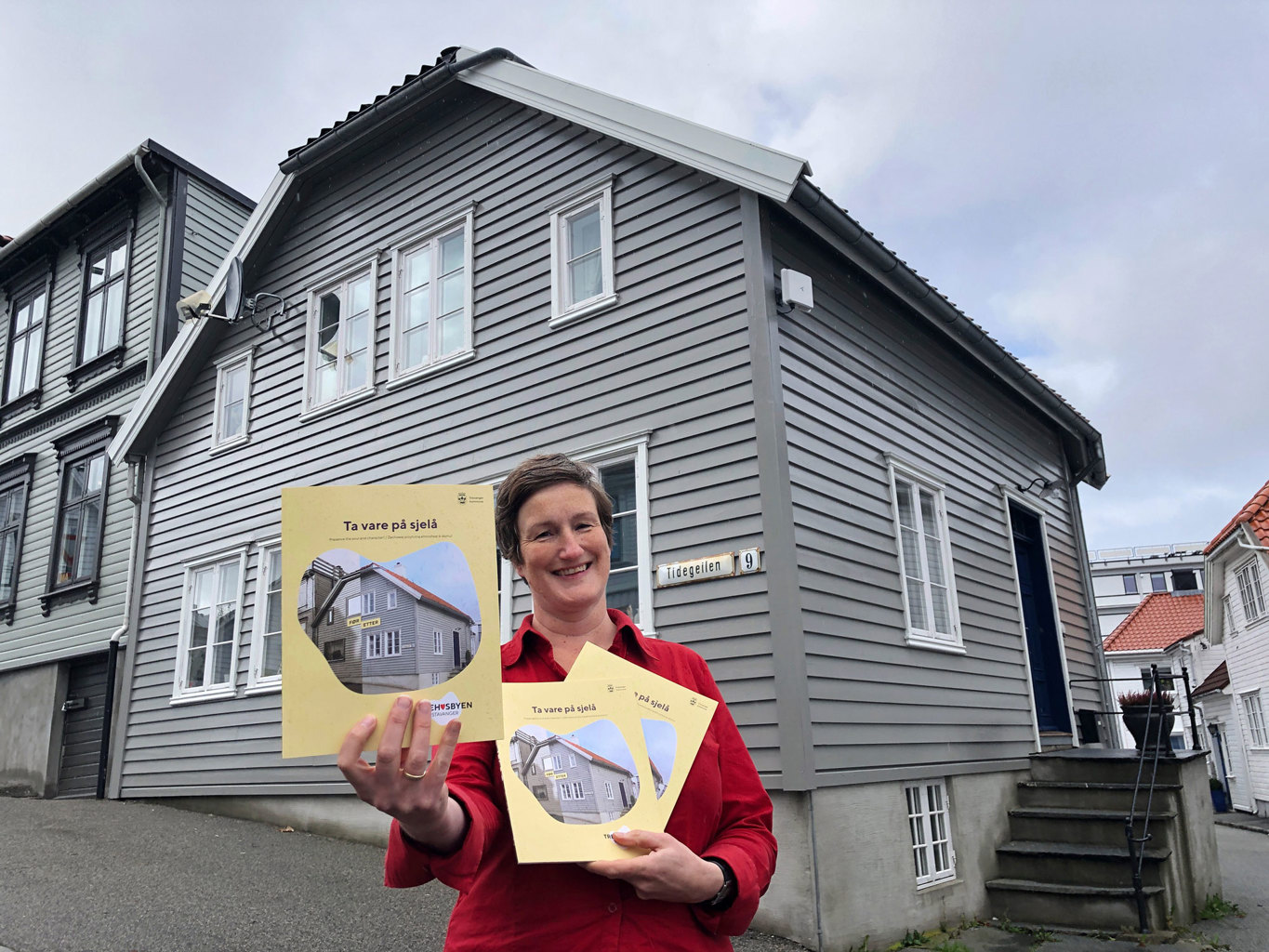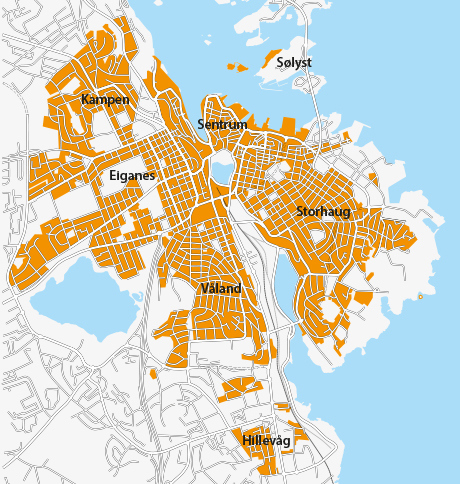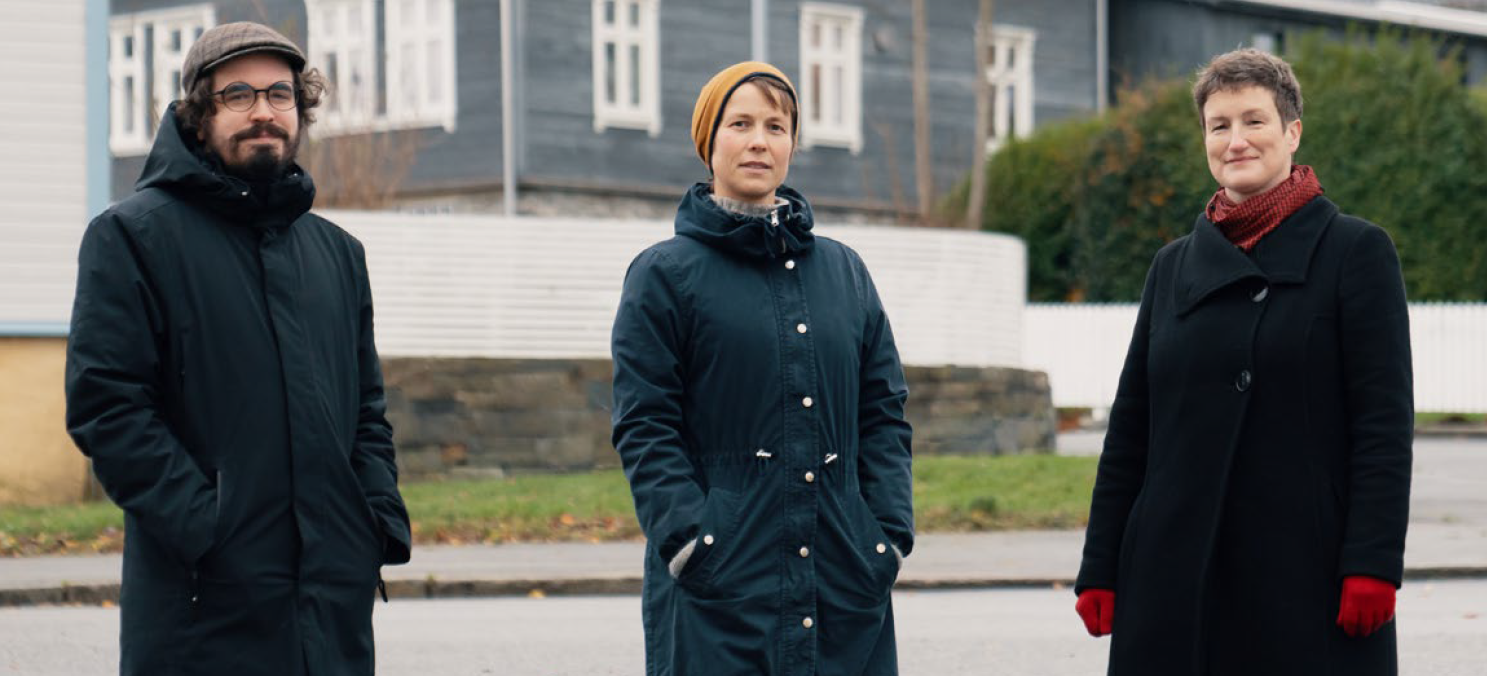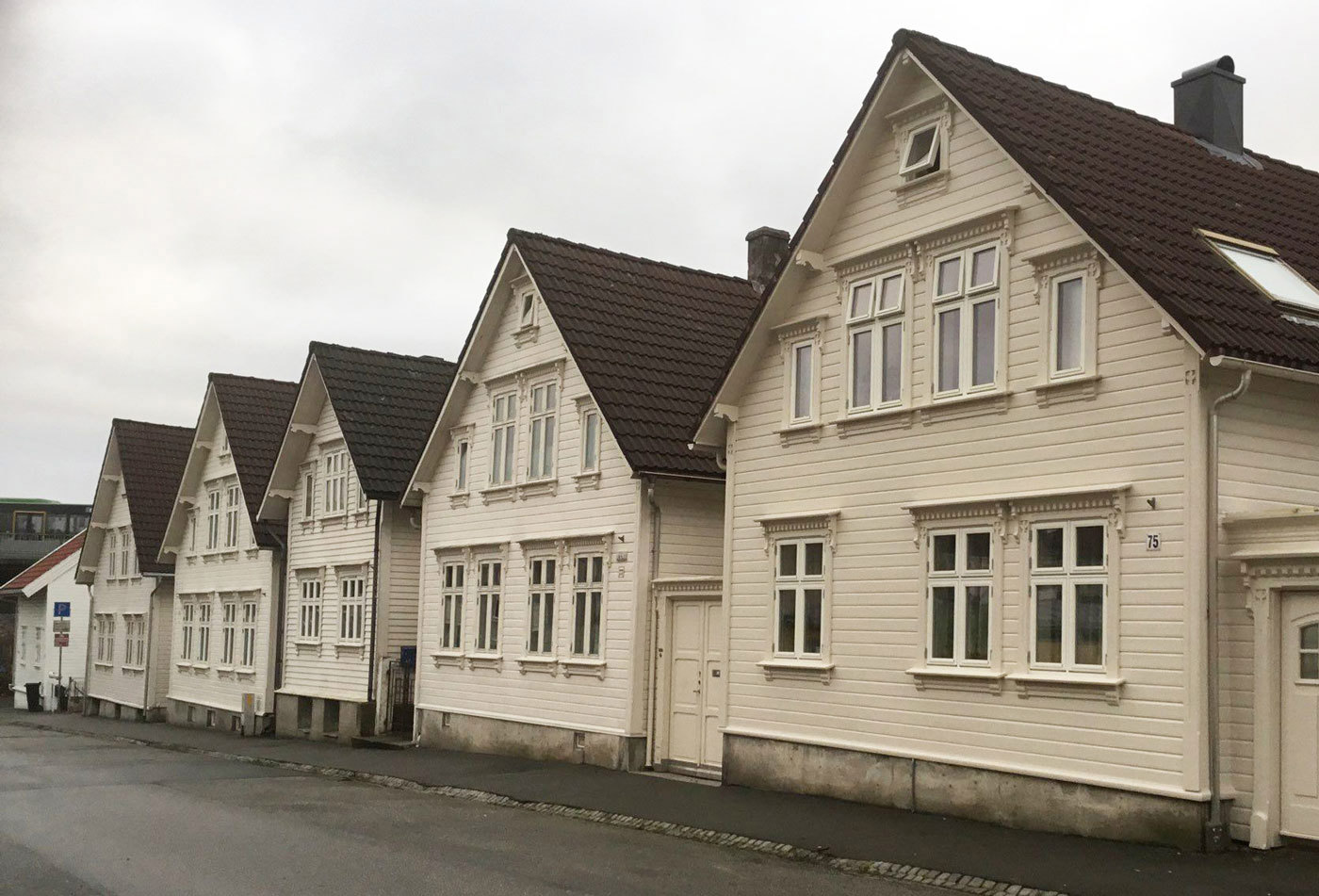- Stavanger has the largest remaining continuous area of wooden houses in Europe. This area is referred to as ‘trehusbyen’.
- Stavanger Municipality is committed to preserving the distinctive character of this area which has significant cultural heritage value both nationally and internationally.
- Specific guidelines have been adopted for any building or improvement works within ‘trehusbyen’.
Guidelines for building works in ’trehusbyen’
IN SHORT
Information in other languages

Byantikvar Hanne Windsholt med heftet «Ta vare på sjelå» som kan hentes hos kommunens Innbyggerservice i Olav Kyrres gate 23.
Check if your house is located within ‘trehusbyen’
‘Trehusbyen’ consists of approximately 8000 houses, representing a variety of architectural styles and building types. The individual buildings as well as areas within ‘trehusbyen’ are of historical and cultural value. Stavanger Municipality has a long-standing ambition and commitment to maintain the original character of this area as well as the original appearance of the individual houses within it. Certain buildings and areas within ‘trehusbyen’ are also listed, and these are subject to stricter rules regarding the use of materials and alterations permitted.
Click on the map to see more detailed boundaries (red dotted line). (The map is in Norwegian only).

These are the guidelines
The guidelines («Retningslinjer for trehusbyen») are based on Stavanger’s Municipal Development Plan (“kommuneplan 2014-2029”) paragraph 3.3.3, page 101 (in Norwegian). The guidelines below apply to the entire area defined as ‘trehusbyen’ (orange colour on the map above).
- The buildings of cultural and historical value are to be preserved and the distinctive atmosphere and environment of the areas shall be maintained and developed.
- The structure and layout of the streets, parks, gardens and valuable trees is to be preserved.
- Any building works that affects the appearance of a building, including the roof, is subject to approval. The application should outline the necessity of the measures to be taken, along with a description of the alteration relative to the buildings’ original style and appearance. The relationship to neighbouring buildings should be detailed on a location plan (‘situasjonsplan’ – this is provided by the municipality) and an outline of the facade.
- Original building elements such as windows, doors, mouldings (including door and window surrounds), façade cladding and roofing materials, are to be replaced only when they no longer satisfy reasonable technical requirements or are damaged to the extent that repairing them is not an option.
- If it is necessary to replace building elements, they should be adapted to the house’s original building style and materials. This applies particularly to windows, front doors, moulding and other façade elements, façade cladding and roofing materials.
- Extensions must be adapted to, and be smaller than, the existing building. Extensions may have a modern design. The same applies to new buildings.
- A new balcony or veranda should only be built where they are a natural element of the historic style of the house. Outdoor spaces should primarily be developed at ground level.
- The design and choice of materials for walls, fences, gateposts, outdoor lighting and exterior fixtures should be in line with the original or dominant style of the area.

Frequently Asked Questions
‘Almost regardless of what you are going to do to the outside of the house, you must contact the municipality first’, says Hanne Windsholt, chief of the Heritage Management Office (Byantikvaren). The rules apply to all the buildings in 'trehusbyen', see map above.
Why can’t I do what I like to my own house?
On the whole you can do what you like indoors, but the outside of the house does not only belong to you, it also belongs to the neighbourhood. Moreover, it is part of the 'trehusbyen' area. Stavanger has Norway’s and most likely Europe’s longest continuous complex of wooden houses. The large number of historic wooden houses is a national cultural heritage. We want to keep and perfect the historic character of each house. That is why you always have to apply to the municipality if you are going to alter the façade. Usually it is possible to make minor alterations!
How do I find out what my house looked like originally
The municipality’s citizens’ advice bureau (Innbyggerservice) or the City Archives can help you find old pictures and drawings. If documentation is ambiguous or insufficient the Heritage Management Office (Byantikvaren) can help you with suggestions for reconstruction based on similar houses. This will be done for you free of charge!
I want to replace the windows. How do I proceed?
Try to find out what the windows looked like originally. Examine the walls in the house to find the original measurements and where the windows were placed. The Heritage Management Office may help you with pictures, or you can make comparisons with houses that have been restored in the neighbourhood. It might be a good idea to check with the Heritage Management Office before you place your order. Be prepared for the right windows not always being ‘off the shelf’ and often costing a little bit extra. On the positive side this will, most likely, increase the value of the house!
Does your house still have the original windows? Don’t replace them! There are ways of increasing their insulation value.
What about doors?
The doors are some of the most important things in the house. If you have an original door, don’t throw it out – nearly all old doors can be repaired and perfected! If the old doors are no longer there, it is worth spending a bit of money on getting the right quality. A good, stylish front door is a gem for the house and could last for a hundred years. A mass-produced, standard door gives a sad first impression and will often have to be replaced after a short time. If you replace an original door with something other than an exact replica, you need to apply to alter the façade.
The roof is leaking! Do I have to keep the old slate tiled roofing sheets?
It depends on which area you are living in and what the zoning plan says. But replacing roofing material or changing the colour of a roof in the wooden house area normally has to be applied for, except if you reintroduce the original roofing material specifically on your house.
Can I paint my house any colour?
You are allowed to change the colour without applying, and there are not many specific rules for which colours to use, but we do want colours that go with the houses’ style. On the websites of Byantikvaren and Bygg og bevar (Build and Preserve) you will find a bit about historic colours.
Can I install solar panels on the roof?
It depends on where you live and how visible the solar panels will be, which means that in this case you have to apply before doing anything. The rules for roofing (or for the appearance of the roof) are quite strict in some parts of the wooden house city. In other words, this is a difficult balancing act between climate considerations and cultural heritage management, so we assess each case separately.
I want to dig out the cellar and put in new windows. What do I have to consider?
If you are going to lower the cellar floor and/or make rooms for permanent residence, you have to apply to the municipality before doing so. In other words, both these things have to be applied for. Changing the size of the windows will also often require a building application (an application for altering the façade). The windows you put in must be in line with the original style of the house.
How do I know if my house is a listed house?
Not possible to give you a short answer – one has to find it out from the municipality’s maps and understand the zoning plan. Not everyone is able to do that. The short answer is perhaps that the wooden house area is a large area where special considerations have to be taken.
But in the wooden house area there are also small areas where the houses are listed through the zoning plan. In these places there are particularly strict rules on the use of materials and details. If you are unsure of what applies for your house, contact the municipality via Innbyggerservice or the Heritage Management Office (Byantikvaren), see contact info below.
Help, I’m in the process of buying a house in 'trehusbyen' and now I see that the windows, that are almost new, are the wrong style. Do I have to replace them if I buy the house?
It depends on how wrong the new windows are and whether it is discovered. It does happen that house owners are ordered to redo things like that, for instance if they have used plastic windows or windows with proportions that are completely wrong. Before you buy the house, if that is what you are going to do, you should confront the present owner with what you have found out.
Once you own the house, you are responsible for the old mistakes as well, and by that time it could be much more difficult to get compensation from the person who made the mistake.
I own the first floor of a two-family house and would really like to return the windows to their original appearance. But the owners on the ground floor do not want to replace the windows. Can I replace my windows all the same? Should I return them to their original style or should I keep them as ‘housewife windows’ (easy windows to clean), so that they are like the neighbour’s windows?
You can replace your windows without taking the neighbour’s windows into consideration and you are free to return them to the way they were originally. In many areas returning the windows to their original style is required even when windows are only replaced on certain parts of the house. It doesn’t matter if a house has two different types of window for a while, because things usually turn out right in the end and that is better than a ‘mistake’ being copied several times.
Are there any subsidy schemes if I want to return the house to its original style?
In some cases, if you are going to repair the house, use very expensive materials or do something special, the Heritage Management Office can write a recommendation to go with your application.
Occasionally, Stavanger politicians set aside funds for the restoration of wooden houses that private individuals can apply for.
I live in the 'trehusbyen' but I live in a brick house. Do different rules apply in that case?
No, the guidelines apply to all the buildings within that area. The brick houses are an important part of the identity and the history of the wooden house city, even if they are made of brick!

Contact information
innbyggerservice@stavanger.kommune.no Phone: (+47) 51 50 70 90
- Visiting address:
-
Olav Kyrres gate 23